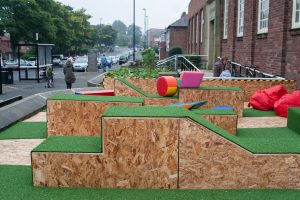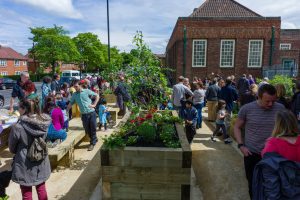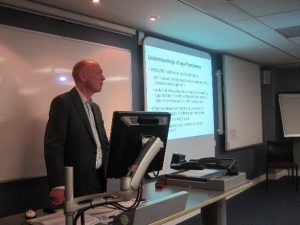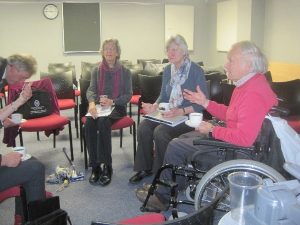In this post, Jenny Crawford reflects on a seminar held earlier in the summer as part of the ESRC Series Neighbourhood Knowing and Working.
The Ultimate in Self-Governance?
Our seminar took place during a momentous week in UK politics. Two days later, England, Wales, Scotland and Northern Ireland were to find themselves facing the immediate economic and social fall-out of Brexit. The ‘Leave’ campaigners were claiming a victory for the principles of sovereignty and self-governance. ‘Remain’ campaigners were lamenting the loss of, among other things, hard-won institutional mechanisms of international co-ordination underpinning the functioning and regulation of markets in the pursuit of public welfare. Even more fundamentally, individuals were revisiting assumptions about their own citizenship and self-identity.
Self-governance implies self-empowerment. Are we caught irrevocably in the belief that the ultimate in self-governance is a state of sovereignty based on exclusive occupation/ownership of territory and decision-making powers and rights? Although our seminar was addressing this question at the scale of the neighbourhood, it seemed to bridge the scales in such debates. Indeed, as Simin Davoudi illustrated in her introduction, both the UK’s European referendum and the practice of neighbourhood planning involve the rhetorical opposition of ‘big state’ versus ‘small state’. While “the smaller the state, the greater the self-governance” may be the dominant discourse, what assumptions underlie this assertion and what cul-de-sacs may it lead to? What do we actually mean by neighbourhood self-governance and empowerment in the context of hugely complex and significant interscalar connections and interdependencies? Such questions lie at the heart of our understanding of a liberal democratic state.
Neighbourhood Renewal is Dead – Long Live the Neighbourhood!
Keith Shaw (Northumbria University) helped us calibrate our deliberations by comparing the New Deal for Communities, launched in the late 1990s, with the present situation. The New Deal promised central government intervention to ensure that “no-one is seriously disadvantaged by where they live”. In contrast, current government policies result in the state no longer being a pro-active player or investor in local regeneration. Instead “neighbourhoods” are being enjoined to wrest resources from market processes through their own policy and ownership interventions. It is hard to see how deprived communities that have been economically and/or socially excluded from such market processes can invent and coordinate such activity without, at least, considerable supporting resources from external sources. Rather, they face ongoing “empowerment to fail”, investing too little to make a difference, in the wrong places to achieve looked for outcomes, and at too great a cost to individuals and local institutions. Indeed Keith argued that, since the New Deal ended, the real rescaling of power has been to city regions and the emerging combined authorities, by-passing local authorities and elected members and constricting empowerment mechanisms for the most local of scales. Public services and investment overall have been cut. Thus the shrinking state shrinks public space and abrogates responsibility for public services to a disempowered voluntary or “community” sector.
Where there are community interests in taking over public services or public policy-making at the local level, the issue of whose interests those are remains difficult to clarify. Inclusive and representative government is designed to counter control by elites at all levels. This has been an issue of bitter debate at the level of EU membership and has played a distinctive role in the outcome of the referendum. Yet it is at the level of the neighbourhood that questions about what mechanisms are in place to balance prejudice, vested interests and outright exclusion of other valid interests, remain most unanswered.
“Don’t tell me I’m in a deprived community!”
The shift in focus from public welfare to citizenship rights and responsibilities holds out new possibilities for public policy and research. In this context, Keith suggested that there is potentially much to be gained from focusing on an asset-based approach as opposed to a deficit model (which can elicit negative responses from those citizens who understandably do not identify themselves as being “deprived”). Rather than citizens being constrained to define their boundaries and what they need (lack) within those boundaries, an asset-based approach encourages innovation in “soft spaces”. Such space can be focused on shared well-being (e.g. affordability and quality of housing or open space), ecological health (including low carbon living and restoration of ecosystems) and creative capacity (through e.g. education, communications and mobility).
Peter Biggers, planning co-ordinator for the production of a neighbourhood plan for ‘front runner’ Alnwick Neighbourhood Forum, discussed what can be achieved in terms of outcomes through what he described as “empowering communities” and “doing everything at the lowest possible level”. He argued that it is the neighbourhood, not the local planning authority, that should decide what a plan contains. However the overall focus remains on the outcome of creation of “better places”. This recalls the tension between a focus on boundaries and identities associated with notions of “place” on the one hand and the exploration of soft space emerging from social and environmental values and relationships. The development of new projects and services, as part of the supplementary community action plan, and improved dialogue with the local authority, described by Peter as being successful outcomes of the neighbourhood planning process in Alnwick, involve such “soft space”.
“Is this our plan or are we being manipulated?”
However, Peter described concern that the new statutory neighbourhood plans have become dominated by complex and centralized rules set by national and local government, which effectively alienate local contributors and require (sometimes expensive) technical help. Among the most challenging aspects for a neighbourhood forum, such as Alnwick’s, are constraints on what can be legitimately included as a “planning matter”. Indeed the Alnwick draft neighbourhood plan faces the loss of twenty policies as a result of its examination, largely on the basis of whether or not they involve “planning issues”. This suggests that at the scale of the neighbourhood plan, hard land use issues and related soft issues of community activity and management interact to such an extent that it does not make sense to separate them artificially. Indeed, separating them could lead to a completely different set of outcomes to that intended by the neighbourhood participants. What is clear, however, is that innovations at the neighbourhood level are being explored, even if these are also the focus of considerable resistance and conflict, e.g. around the focus on affordable housing and the location and design of new housing developments in relation to green belt and open space.
The treatment of conflict in such arenas offers particular research interest as its management gives insights into the capacity of governance infrastructures at the neighbourhood level and their implications for wider decision-making. Community planning approaches embrace techniques that supplement campaigns, voting and referenda, in order to reach out to the otherwise excluded in an important development of representative democracy. Liz Juppenlatz’ study of the neighbourhood plan for the rural area of Tarset and Greystead in Northumberland revealed a process of renegotiation of local governance space between the parish council, the neighbourhood plan steering group and the local authority. Both Peter and Liz argued that neighbourhood planning groups have the capacity to be more representative of the broad spectrum of interests, assets and needs than has hitherto been the case in either local or parish council structures. This is not a cheap option for government, but it reframes the relationship between the state and society to reflect a growing understanding of the meaning of self-governance. It also suggests a greater focus on a recognition of planning as an integral aspect of citizenship, challenging not only market-driven but “feudal” and class-based exclusions in active engagement for change.
It is in this context that the capacity for local planning authorities to assume a bespoke mentoring role in relation to neighbourhood planning processes and products could be integral to the redefining of governance and self-governance. Such a role would involve both technical and communicative input, which in turn would require coordination, quality control and reflexive monitoring. This could be a critical aspect of the role of local elected members, positioning local authorities as enablers, first and foremost, of democratic representation and civic action, rather than primarily of services or, as has been increasingly the case, of service markets.
John Sturzaker of Liverpool University suggested that while wealthier (and predominantly rural) areas, which have dominated neighbourhood planning activity to date, may be coming up against the limitations of neighbourhood planning for securing control over local development, poorer/urban areas are increasingly seeing the potential of neighbourhood planning in the context of hollowed out, disempowered local authorities. Using examples from Liverpool and the Wirral, he described how some urban areas appear to be beginning to use neighbourhood planning as a legitimating focus for building social capacity and engaging disempowered voices with new networks and resources.
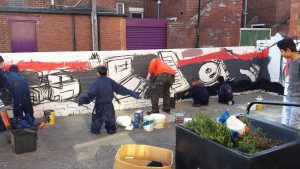
Reclaim the Lanes
Hard space – soft space
Newcastle’s Greening Wingrove initiative, as described by Nigel Todd, pointed to the type of neighbourhood planning approach that could emerge in such urban areas, building on community development initiatives for both hard and soft space. Wingrove is described as a mixed urban area, of some 10-15,000 people, that is not only the most ethnically diverse area in North East but also among its most economically polarized populations. Using some financial help from Newcastle City Council’s participatory budget, the initiative has responded to the area’s dubious honour of receiving a Grotspot Award to develop “a different way of looking”. This involves a predominantly environmental lens, focused on activities such as litter removal, gardening, recycling rainwater etc, with a particular focus on shared civic space in Nunsmoor Park (described as “the heart of our area”). The award of Big Lottery Communities funding with a focus on combating climate change has opened up new possibilities for the leading residents group and a nascent Community Cooperative Group (CIC) to develop business planning and the further development of ambitions for local self-governance.
Among the objectives of the residents’ group in Wingrove is the engagement of the hundreds of private landlords in the area, currently subsidised by housing benefit of around £2.5 million per year but often with little expertise in management, in improving both environmental and social performance. Such ambitions for advocacy through environmental change, as described by Dave Webb, open up potential for what he termed a “critical praxis” that seeks new approaches to planning using action research. Dave referred to Lydon and Garcia (2015) in their book Tactical Urbanism describing the task of “breaking through the gridlock of what we call Big Planning” by working with popular discourses. He introduced recent work in the Reclaim the Lanes project in which marginalized groups of residents in part of Wingrove have been encouraged to engage in action and the early stages of planning for the use of environmental management resources, through events and activities designed to build trust and deliver immediate and tangible value for local people.
The core contribution of social learning based on action to local governance was also illustrated by Julia Heslop’s description of self-build housing initiatives. Again this involves a combination of hard and soft space. In this case such space is that of homes that work for the social and economic circumstances of particular groups, as determined by those groups themselves, whether working in Tirana in Albania or in a Crisis-led initiative for homeless people in Ouseburn in Newcastle. Roger Burrows’ research into the “super-rich” neighbourhoods of London provided a challenging and revealing contrast. It underlined the trump cards held by wealth, land ownership and largely free markets in land and fixed assets. Sixty-two individual billionaires have the same amount of wealth as the poorest half of world’s population. Around half a million of the world’s “High Net Worth Individuals” now choose to live around the great parks of London. Against such a hand, even “powerful” communities, with high levels of social and economic capacity have struggled to have a voice in the leafy environs of Highgate. The inequalities and exclusions generated by these markets can all too clearly be seen to require intervention at the level of national and international governance.

London skyline
Enter Doggerland
The seminar presentations and discussions were followed by a participatory performance of The Town Meeting by theatre group Cap-a-Pie, devised in collaboration with Paul Cowie to explore group processes in community planning. The performance introduces participants to issues of power, representation and policy-making in the context of acting out decision-making about constrained and conflicting options for the development of a small industrial town in the windswept countryside of an imaginary Doggerland. Those who took part rapidly found themselves railroaded into well-worn pathways and communication cul de sacs recognizable from real-world explorations of development governance.
At the outset of the seminar, Simin had summarised the underlying question for local governance as being what type of government do we have/want in order to achieve what ends? The presentations and discussions outlined the potential for researchers to work with development policymakers and practitioners, at and across all levels, to engage with complexity and diversity. This challenges simplistic perceptions of community identity and belonging, while forging new assets and capacities that can be realized by citizens at every level. The nexus of knowledge generation, knowledge exchange and policy development can be argued to be at its most creative as part of learning, collaborative planning communities. The instability of current governance relationships is opening doors to different and potentially more inclusionary kinds of conversation about social imaginaries of space and identity, as well as more exclusionary and destructive practices. These present a clear and urgent programme to be undertaken by such planning communities.
Jenny Crawford is a chartered town planner with extensive experience in strategic and environmental planning policy at all scales from community level to national.
She is currently studying full-time for doctorate at the School of Architecture, Planning and Landscape. Her focus is on governance, planning and ecosystem management, using coastal case studies.
Email: j.e.j.crawford@ncl.ac.uk

